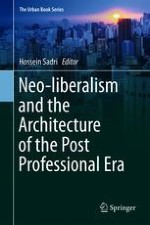2018 | OriginalPaper | Chapter
2. The Trouble with Architecture
Author : Graeme Bristol
Published in: Neo-liberalism and the Architecture of the Post Professional Era
Publisher: Springer International Publishing
Activate our intelligent search to find suitable subject content or patents.
Select sections of text to find matching patents with Artificial Intelligence. powered by
Select sections of text to find additional relevant content using AI-assisted search. powered by
Abstract
-
Its history—the problems of the profession have deep roots going back to the shift from the Gothic Master Builder to Alberti and the ‘Renaissance Man’.
-
Professional education—it has been said that an architecture degree provides the graduate with the most well-rounded education possible. A myth? There is also a troubling chasm between the school training future architects and the profession which has to take them in.
-
Globalization—between WTO and GATS, APEC negotiations on the trade in architectural services, and the newly proposed TPP agreement, there are a number of problems with architecture, tied as it is to culture, freely crossing borders to practice architecture anywhere in the world.
